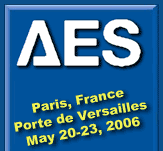

Home | Technical Program | Exhibition | Visitors | Students | Press
Last Updated: 20060417, mei
P31 - Posters: Audio Recording and ReproductionTuesday, May 23, 14:00 — 15:30
P31-1 Multichannel High Performance Analog Volume Control with a New Serial I2C/SPI Compatible Control Port—Vivek Saraf, Chad Hardy, John Tucker, Johann Gaboriau, Cirrus Logic, Inc. - Austin, TX, USA
A new scheme for digitally operating an 8-channel high-performance analog volume control is proposed. Along with being I2C/SPI compatible, this scheme is faster and less complex than existing solutions due to its inherent advanced support for group/individual addressing. The volume control varies monotonically all the way from -96 dB to +22 dB in 0.25 dB steps. The chip achieves 110 dB THD+N, 1.8 µVrms total integrated noise and an interchannel isolation of greater than 120 dB.
[Poster Presentation Associated with Paper Presentation P30-1]
Convention Paper 6847 (Purchase now)
P31-2 Evaluation of Ambience Microphone Arrangements Utilizing Frequency Dependent Spatial Cross Correlation (FSCC)—Teruo Muraoka, University of Tokyo - Tokyo, Japan
Ambience in stereophonic recording is mostly determined with the main microphone system. The authors examined the effect utilizing Frequency-dependent Spatial Cross Correlation (FSCC), which is defined as a cross correlation of two outputs of the above-mentioned microphone system. If the recording sound field is diffusive, the above FSCC is desired to be zero. However, actual FSCC varies within -1 to 1 depending on frequency; that is brought by the microphone’s directionality and location. The authors theoretically analyzed FSCCs of typical main microphone systems such as AB system, ORTF system, WF system, and MS system and discovered that the FSCC of MS system becomes uniformly zero under conditions when its azimuth of directional angles is set at 132-degrees. This was proven experimentally, and excellent ambient recording was achieved.
[Poster Presentation Associated with Paper Presentation P30-2]
Convention Paper 6848 (Purchase now)
P31-3 Parameter Estimation of Dynamic Range Compressors: Models, Procedures, and Test Signals—Uwe Simmer, University of Applied Sciences Oldenburg/Ostfriesland/Wilhelmshave - Oldenburg, Germany; Denny Schmidt, University of Bremen - Bremen, Germany; Joerg Bitzer, University of Applied Sciences Oldenburg/Ostfriesland/Wilhelmshave - Oldenburg, Germany
An analysis of digital dynamic range compression algorithms is presented. They are studied by employing a single-band feed-forward compressor model allowing the use of independent attack and release times for both RMS detection and gain smoothing. Artificial test signals for measuring the static and dynamic compressor characteristics are discussed. The parameters of the compressor model are estimated by fitting the model output to the output of the compressor under test by using the simplex method. The results are verified by comparing the output levels of the actual and the fitted compressor for real world audio samples.
[Poster Presentation Associated with Paper Presentation P30-3]
Convention Paper 6849 (Purchase now)
P31-4 3-D Sound Field Recording with Higher Order Ambisonics—Objective Measurements and Validation of a 4th Order Spherical Microphone—Sébastien Moreau, Consultant - Colombes, France; Jérôme Daniel, Stéphanie Bertet, France Telecom R&D - Lannion, France
Higher Order Ambisonics (HOA) is a flexible approach for representing and rendering 3-D sound fields. Nevertheless, lack of effective microphone systems limited its use until recently. As a result of the authors’ previous work on the theory and design of spherical microphone arrays, a 4th order HOA microphone has been built, measured, and used for natural recording. The present paper first discusses theoretical aspects and physical limitations proper to discrete, relatively small arrays (spatial aliasing, low-frequency estimation). Then it focuses on the objective validation of such microphones. HOA directivities reconstructed from simulated and measured 3-D responses are compared to the expected spherical harmonics. Criteria like spatial correlation help characterizing the encoding artifacts due to the model limitations and the prototype imperfections. Impacts on localization criteria are evaluated.
Convention Paper 6857 (Purchase now)
P31-5 Audio Cable Distortion Is Not a Myth!—Richard Black, Richard Black Associates - London, UK
Specialist audio cables are often sold to the consumer on the basis of eyebrow-raising claims for technical performance, though to date no repeatable test has shown any effect more surprising than mild frequency-selective attenuation. However, because the loudspeaker load is typically nonlinear and causes harmonic currents to flow, finite impedance in an audio cable does indeed cause harmonic voltages to appear across the loudspeaker. This distortion term is similar to, or even greater than, that produced by the amplifier’s intrinsic nonlinearity.
Convention Paper 6858 (Purchase now)